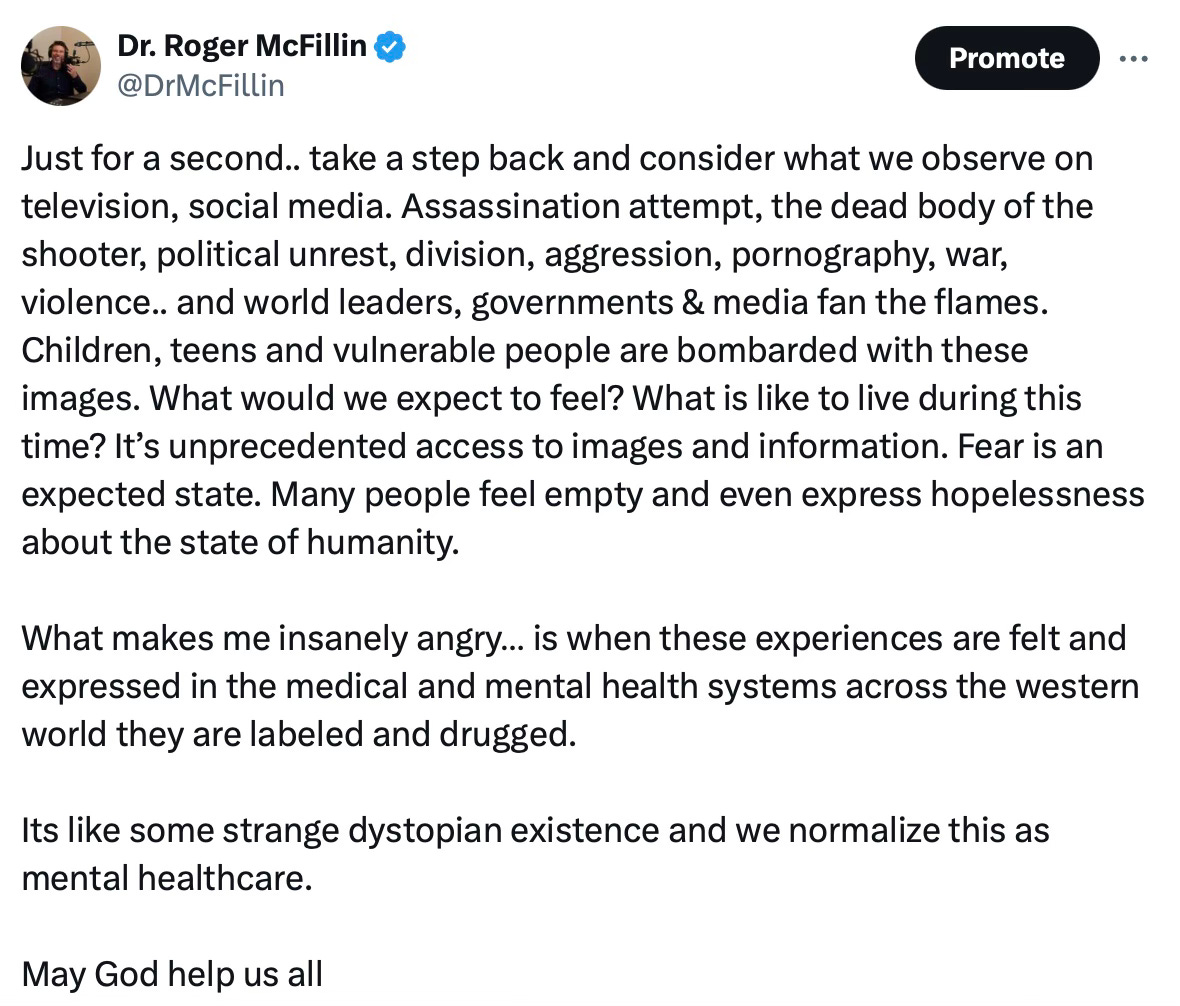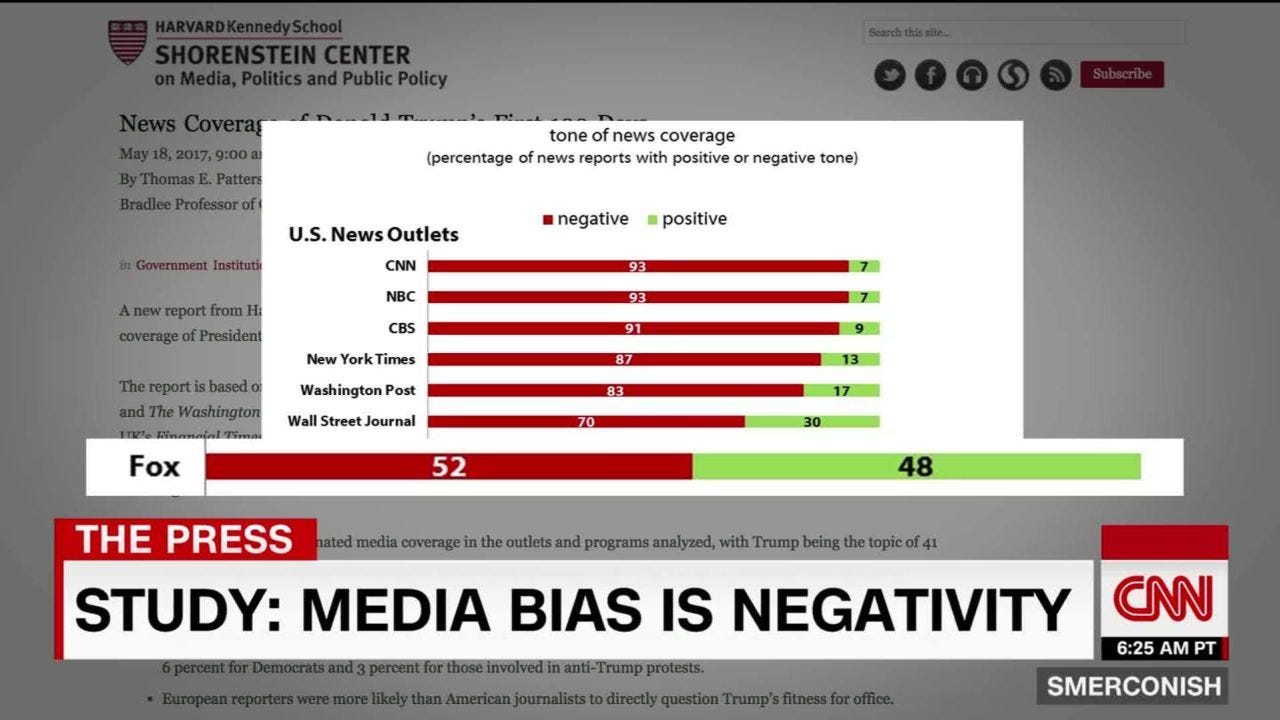Brainwashed: The Sinister Influence of News, Media, and Pornography
How repeated exposure is shaping our reality and how to reclaim our minds
It's 5 AM on a Monday, and I'm wide awake in a Fargo, North Dakota hotel room. My son is about to compete in the Freestyle National Wrestling Championships – a moment that should fill me with anticipation and excitement. Instead, I have found myself captivated by the eerie glow of my phone, endlessly scrolling through a digital maelstrom of shocking images and inflammatory comments.
The recent assassination attempt on Donald Trump at a Pennsylvania rally has ignited a firestorm of intense reactions across social media platforms. Graphic footage of the incident proliferates online, replaying the moment a bullet narrowly misses the former president's head. The video captures Trump's expression shifting from unaware to stunned in a split second. Abruptly, the scene cuts to the grim aftermath: the assailant's lifeless body lying on the ground.
As I read through countless reactions, I feel my mood darkening. The vitriol in the comments section is palpable, and it's affecting me more than I'd like to admit. The stark contrast between the peaceful quiet of my hotel room and the digital chaos on my screen is disorienting.
As I continue scrolling, I become acutely aware of how this digital deluge is poisoning my mindset. The disturbing imagery and incendiary comments seep into my psyche, casting a dark shadow over the dawning day. My thoughts spiral, extending beyond my own experience to the broader implications.
I picture young children, their developing minds exposed to this maelstrom of violence and vitriol. I think of teenagers, already navigating a tumultuous stage of life, now bombarded with this graphic content. The vulnerable members of society, those struggling with mental health issues, come to mind—how are they processing this onslaught of information?
A creeping sense of despair takes hold as I contemplate humanity's response to tragedy. The knee-jerk reactions, the lack of empathy, those seeking revenge, the gleeful spread of misinformation—it all paints a bleak picture of our collective psyche.
As dawn breaks over Fargo, I find myself caught between two worlds: the digital realm of endless news updates about yesterday's shocking events, and the tangible reality of the day ahead.
Digital Toxicity: When News Becomes a Slow-Acting Poison
As I finally set my phone aside, yesterday's violent images still flicker behind my eyelids. I can't help but contemplate how this relentless flow of information is affecting me. It's no longer just about staying informed—it's about how this digital torrent is reshaping my perception of reality.
I'm reminded of a large body of evidence suggesting that repeated exposure to negative news stories increases people's tendency to focus on and remember negative information in their daily lives.
As we consume a steady diet of distressing headlines and alarming reports, our brains become primed to anticipate danger and focus on potential threats. This constant state of alertness can lead to increased levels of stress, anxiety, and even symptoms of depression. Over time, this negativity bias can color our perception of the world, making us more likely to interpret ambiguous situations in a pessimistic and threatening light. The cumulative effect can manifest as persistent worry, irritability, and a general sense of unease, even when we're not actively engaging with news media.
It’s well known that people who consume predominantly negative news demonstrate increased anxiety and a tendency to catastrophize in their personal lives. It's a sobering realization—our media diet isn't just informing us; it's fundamentally altering our worldview and emotional state.
Researchers have observed that prolonged exposure to graphic violence can trigger two distinct psychological processes: sensitization or desensitization. Sensitization heightens an individual's emotional distress when viewing violent imagery, while desensitization induces a numbing effect, habituating individuals to disturbing content. This numbing phenomenon, characterized by diminished emotional responses to distressing stimuli, has been particularly noted in individuals frequently exposed to violent video games.
The sun is now rising over Fargo and I am faced with a choice that feels increasingly critical: do I continue to let this digital drip of distress shape my reality, or do I consciously redirect my attention?
Understanding the psychological mechanisms at play—the attentional biases, the emotional impacts, the way we construct our realities through what we focus on—empowers me to make a more informed decision. It's not about ignoring the world's problems, but about finding a balance that allows me to stay informed without sacrificing my mental well-being.
The ubiquity of visual media in our lives prompts reflection on its profound influence on our shared psyche. While I, as a seasoned professional, may feel somewhat insulated from its effects, I'm keenly aware of the significant impact these pervasive images have on younger generations.
The Pornification of Everything
Not too long ago, a mother sobbed in my office, recounting how she found her adolescent son's search history. "It was like looking into a nightmare," she said. "How can he ever have a normal relationship after seeing those things?" Her fears aren't unfounded.
Pornography exposure can negatively impact adolescent sexual development, shaping attitudes, beliefs, and behaviors. Studies suggest it may instill unrealistic expectations about sex, emphasizing physical over emotional aspects. Increased pornography consumption correlates with sexual preoccupation, permissive attitudes, and objectification of women.
Adolescent males exposed to sexually violent media may develop more accepting views of dating and sexual violence. Behaviorally, pornography exposure is associated with increased casual sex, high-risk sexual practices, and potentially higher levels of sexual aggression in male adolescents.
For young women, the consequences are equally alarming. Pornography exposure in adolescent girls and young women can have significant and multifaceted impacts on their psychological, social, and sexual development. While research in this area is ongoing, several key effects have been identified:
Self-image and body perception are often negatively affected by pornography exposure. Many pornographic materials present unrealistic body standards and beauty ideals, which can lead to increased body dissatisfaction and lower self-esteem among young women. This may contribute to the development of eating disorders or unhealthy body modification practices.
Pornography can shape sexual expectations and behaviors in ways that may be detrimental. Young women exposed to pornography may develop skewed perceptions of what constitutes normal or expected sexual behavior. This can lead to pressure to engage in acts they're uncomfortable with or to prioritize their partners' pleasure over their own comfort and desires. Additionally, pornography often portrays unrealistic scenarios of sexual encounters, which may create anxiety or disappointment when real-life experiences don't match these depictions.
Relationship dynamics and attitudes towards intimacy can also be influenced. Pornography frequently depicts casual, non-emotional sexual encounters, which may impact how young women view relationships and emotional connections in sexual contexts. Some studies suggest that frequent pornography use is associated with difficulties in forming and maintaining intimate relationships.
Recently, I've observed a disturbing pattern in my practice: increasingly younger girls seeking validation through provocative online personas. One client, a 14-year-old, tearfully confessed to running a secret Instagram account filled with suggestive selfies. "It's the only way to get likes," she explained, her words a chilling indictment of our hypersexualized culture.
This race to the bottom of self-objectification isn't just anecdotal. A study by Daniels and Zurbriggen (2016) published in the Journal of Adolescence found that girls who post sexualized photos on social media receive more peer approval but are viewed as less competent and less suited for friendship. The researchers noted that this creates a troubling dynamic where girls are rewarded for sexualization but simultaneously devalued.
In my practice, I see the consequences of this firsthand. These young clients often report feeling empty and disconnected, their self-esteem precariously balanced on the knife-edge of likes and follows. One 15-year-old described it as "feeling hollow inside, like I'm just a shell for other people to look at." This early sexualization not only distorts their self-image but also sets the stage for a lifetime of seeking external validation at the expense of genuine self-worth and meaningful connections.
The neurological impact is perhaps the most concerning. A 2014 study in JAMA Psychiatry revealed that frequent pornography consumption was associated with decreased gray matter in brain regions linked to reward sensitivity. I've seen this play out in the increasing number of young adults seeking help for porn-induced erectile dysfunction and inability to form emotional connections.
The influence of pornography extends far beyond explicit online content, permeating various aspects of popular culture. From music videos and advertisements to fashion trends and social media, pornographic aesthetics and themes have become increasingly mainstream. This normalization sends potent messages to young people about sexuality, body image, and relationships.
For girls, it often reinforces the idea that their worth is primarily tied to sexual appeal and physical appearance, promoting unrealistic beauty standards and encouraging self-objectification.
Boys, on the other hand, may internalize notions of masculinity that emphasize sexual conquest and dominance, while downplaying emotional intimacy. Both genders are exposed to simplified, often aggressive depictions of sex that lack nuance, consent, and emotional connection.
While we are undoubtedly the architects of our personal realities, the building blocks we use are heavily influenced by our environment and experiences. The digital age has exponentially expanded our exposure to diverse stimuli, from news and social media to entertainment and pornography. This constant stream of information shapes our perceptions, beliefs, and behaviors in both subtle and profound ways… and its making us miserable!
How do we reclaim our minds?
Digital Detox and Reclaiming Our minds
“If a tree falls in a forest and no one is around to hear it, does it make a sound?”
-George Berkeley
Where our attention goes our energy flows. If we minimize or avoid negative and harmful content, does it really exist in our world? I would argue that what we choose to consume and where we focus our attention becomes our state of being. The reality in which we live.
This isn't a call for willful ignorance, but rather an invitation to reconsider what we allow to occupy our mental space. Every day, the world brims with beauty, love, and countless acts of kindness and service that often go unnoticed in the relentless cycle of negative news media.
By curating our attention towards these positive aspects, we reshape our perception of the world around us. The human mind, prone to confirmation bias, tends to seek out information that aligns with existing beliefs, potentially reinforcing a skewed worldview. However, this same psychological tendency can be harnessed for positive change.
By consciously directing our focus towards uplifting content, we can create a self-reinforcing cycle of positivity. In this light, our attention becomes our most powerful tool for freedom—the freedom to choose the reality we wish to inhabit and the person we aspire to become.
Gratitude Practice
A daily morning gratitude practice can be a powerful tool in shaping our perception of reality and directing our attention towards the rewarding aspects of life. By starting each day with a conscious acknowledgment of the things we're thankful for, we prime our minds to notice and appreciate the good in our lives.
This practice doesn't just set a positive tone for the day; it actually rewires our brains over time. Neuroplasticity research suggests that regularly focusing on gratitude can strengthen neural pathways associated with positive thinking, making it easier for our brains to default to grateful thoughts.
This intentional focus on gratitude can have a ripple effect on our attention throughout the day. As we train ourselves to look for things to be grateful for, we become more attuned to positive experiences and interactions. This heightened awareness can help counteract the negativity bias that often dominates our perception, especially in a media landscape that tends to emphasize alarming or sensational news. By actively cultivating gratitude, we're not denying the existence of challenges or hardships, but rather choosing to give equal or greater weight to the positive aspects of our lives.
Complementing the morning practice with an evening reflection can further reinforce this positive mindset. Before retiring for the night, take a few moments to review the day and identify specific moments or experiences you're most grateful for. This could be as simple as a kind gesture from a stranger, a moment of peace in a busy day, or an accomplishment at work.
By bookending our days with gratitude, we create a framework that encourages a more balanced and appreciative outlook on life. This nightly practice also serves as a form of positive reflection, helping to consolidate memories of good experiences and potentially improving our overall sense of well-being and life satisfaction.
Over time, this dual practice of morning and evening gratitude can significantly shift our focus, making us more resilient to negative influences and more capable of recognizing and savoring the beauty and goodness that surround us daily.
Digital Discernment
Minimizing exposure to toxic news media requires a balanced approach that distinguishes between factual reporting and sensationalism. The goal is to stay informed about important events without falling into the trap of excessive, dramatized coverage.
Key strategies include:
1. Selective sourcing: Choose reputable news outlets known for balanced reporting. Opt for concise daily or weekly summaries rather than constant updates.
2. Time management: Set specific, limited times for news consumption. Avoid continuous checking throughout the day.
3. Digital boundaries: Use technology to filter content, turn off push notifications, and create "no-news" zones in your daily routine.
The challenge lies in exercising the discipline to resist the urge for more information once you've grasped the essential facts of an event. This requires recognizing the difference between necessary information and sensationalized content designed to keep you engaged.
Developing this discipline involves:
1. Self-awareness: Recognize when you're scrolling or channel surfing out of habit rather than genuine need for information.
2. Setting limits: Once you understand the basic facts of an event, consciously decide to stop seeking further coverage.
3. Redirecting attention: Have alternative activities ready to engage in when you feel the pull towards excessive news consumption.
4. Reflection: Regularly assess how your news consumption affects your mood and outlook, using this insight to refine your habits.
Remember, the aim is not ignorance, but a more intentional and healthy relationship with news media. This approach allows you to stay informed without becoming overwhelmed by the constant stream of sensationalized content.
Building a Porn-Resistant Environment for You and Your Family
Pornography, once relegated to the shadows, now infiltrates our daily lives with alarming ease, its tendrils reaching into social media, advertising, and even mainstream entertainment. This ubiquitous presence poses a grave threat not just to our own mental well-being, but to the healthy development of our children, potentially warping their understanding of relationships and sexuality before they've even begun to explore these aspects of life. The stakes couldn't be higher: we're fighting for nothing less than the sanctity of our minds and the future of how we connect as human beings.
Here are practical strategies for building a porn-resistant environment for yourself and your family:
1. Comprehensive Device Protection:
Install robust content filtering software on all devices (computers, tablets, smartphones)
Enable safe search on all browsers and search engines
Utilize parental controls on streaming services, gaming consoles, and smart TVs
2. Network-Level Security:
Set up content filtering at the router level to protect all devices on your home network
Use DNS filtering services for an additional layer of protection
3. Accountability Measures:
Use accountability software that reports internet activity to a trusted partner
Keep computers and devices in common areas of the home
4. Digital Literacy Education:
Teach family members about online safety and the potential harms of pornography
Discuss how to respond if they accidentally encounter explicit content
5. Open Communication:
Foster an environment where family members feel comfortable discussing online experiences
Have regular check-ins about digital habits and encounters
6. Alternative Activities:
Encourage engagement in sports, hobbies, and face-to-face social interactions
Promote reading and creative pursuits as alternatives to screen time
7. Mindful Media Consumption:
Curate a list of positive, family-friendly media sources
Teach critical thinking skills to evaluate media content
8. Time Management:
Set clear rules for device usage, including time limits and device-free periods
Use apps that track and limit screen time
9. Lead by Example:
Model healthy digital habits and responsible internet use
Be transparent about your own strategies for avoiding inappropriate content
10. Regular Audits:
Periodically review browsing histories and app downloads on family devices
Stay informed about new apps and platforms popular among youth
Remember, the goal is to create an environment that not only blocks inappropriate content but also fosters healthy attitudes towards relationships, sexuality, and technology use. This approach combines technical solutions with education and open dialogue.
In an age where the complexity of mental health is increasingly reduced to simplistic, pill-shaped solutions, we must awaken to the larger forces at play. The bombardment of our minds with curated negativity, sensationalized news, and ubiquitous pornography isn't just incidental—it's a calculated assault on our mental resilience and critical thinking.
This article merely scratches the surface of how profoundly our minds are influenced, and consequently, how our mental health is impacted. If we truly desire mature, meaningful conversations about mental well-being, we must fiercely resist the myriad forces attempting to manipulate us.
Make no mistake:
WE ARE IN A WAR
A war for the sovereignty of our minds, for our ability to think clearly and independently.
In this battle, protecting our minds from undue influence isn't just self-care—it's an act of rebellion. It's about fortifying ourselves to be strong, present, and critically engaged in our lives and communities. As the pressure mounts to accept simplified narratives and quick-fix solutions, we must stand firm.
Our freedom—of thought, of choice, of self-determination—hangs in the balance. The fight for mental health is, at its core, a fight for the very essence of our humanity and liberty.










I have been struggling emotionally all week. I realized it does have to do with the recent events and the images I'm seeing. It does foment dread and despair...
What a timely essay. I haven't felt this bombarded with bad news since the beginning of Covid. I noticed those same feelings of high alert and anticipation of doom gloom starting to sneak in and poison otherwise totally fine days. This was an excellent reminder on what is at stake. I heard a fellow substacker, Paul Kingsnorth say it this way: put the peace of your heart before everything else.